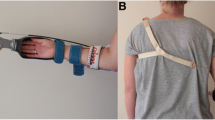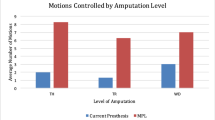Abstract
The uprising of versatile wearable technology allows for the development of assistive aids with increased functionality. With this improved functionality, often complexity of use also increases. In particular, wearable multi-channel emg sensors combined with versatile programmable output and emg pattern classifiers, allows to steer prostheses with mechanical functionality in multiple degrees of freedom (DOF). As it is essential for arm amputees to learn how to use newly multiple DOF prosthesis with improved functionality, there is a growing need for a substantiated training program. The aim of this controlled pilot study was to investigate the effect of a prosthetic training session on the functionality of adult non-amputees wearing a prosthetic hand simulator. The prosthetic hand simulator was dedicatedly developed to that end. Ten participants were recruited from the University of Antwerp, aged 18–25 years. All participants were able-bodied and right-handed adults, with normal or corrected-to-normal vision, no neurological or upper extremity musculoskeletal problems, and no earlier experience with a prosthetic simulator. The SHAP test was performed with a prosthetic simulator to obtain an impression of the functionality. Mann-Whitney U test confirmed the comparability of scores of the control group (N = 5) and intervention group (N = 5) at baseline (p = 0.530). Further, a statistically significant difference between first and last test-sessions could be identified in both groups (both p = 0.042). In addition, a trend (p = 0.056) in difference in improvement could be observed in favor of the intervention group. Results emphasize the importance of learning a correct and functional employment of multiple DOF artificial hand prosthesis and thus improving functionality in daily use.
Access this chapter
Tax calculation will be finalised at checkout
Purchases are for personal use only
Similar content being viewed by others
References
Segil, J.L., Huddle, S.A.: Functional assessment of a myoelectric postural controller and multi-functional prosthetic hand by persons with trans-radial limb loss. IEEE Trans. Neural Syst. Rehabil. Eng. 25, 618–627 (2017)
Light, C.M., Chappell, P.H., Kyberd, P.J.: Establishing a standardized clinical assessment tool of pathologic and prosthetic hand function: normative data, reliability, and validity. Arch. Phys. Med. Rehabil. 83, 776–783 (2002)
Dalley, S.A., Bennett, D.A., Goldfarb, M.: Preliminary functional assessment of a multigrasp myoelectric prosthesis. In: 2012 Annual International Conference of the IEEE Engineering in Medicine and Biology Society (EMBC), pp. 4172–4175 (2012)
Bouwsema, H., Van der Sluis, C.K., Bongers, R.M.: Movement characteristics of upper extremity prostheses during basic goal-directed tasks. Clin. Biomech. 25, 523–529 (2010)
Segil, J.L., Controzzi, M.: Comparative study of state-of-the-art myoelectric controllers for multigrasp prosthetic hands. J. Rehabil. Res. Dev. 51, 1439 (2014)
Hill, W., Kyberd, P., Hermansson, L.N., Hubbard, S., Stavdahl, Ø., Swanson, S.: Upper limb prosthetic outcome measures (ULPOM): a working group and their findings. JPO: J. Prosthet. Orthot. 21, P69–P82 (2009)
Metcalf, C.D., Woodward, H., Wright, V., Chappell, P.H., Burridge, J.H., Yule, V.T.: Changes in hand function with age and normative unimpaired scores when measured with the Southampton hand assessment procedure. Br. J. Hand Ther. 13, 79–83 (2008)
Burgerhof, J.G., Vasluian, E., Dijkstra, P.U., Bongers, R.M., van der Sluis, C.K.: The Southampton hand assessment procedure revisited: a transparent linear scoring system, applied to data of experienced prosthetic users. J. Hand Ther. 30, 49–57 (2017)
Vasluian, E., Bongers, R.M., Reinders-Messelink, H.A., Burgerhof, J.G., Dijkstra, P.U., van der Sluis, C.K.: Learning effects of repetitive administration of the Southampton hand assessment procedure in novice prosthetic users. J. Rehabil. Med. 46, 788–797 (2014)
Kyberd, P.J.: The influence of control format and hand design in single axis myoelectric hands: assessment of functionality of prosthetic hands using the Southampton hand assessment procedure. Prosthet. Orthot. Int. 35, 285–293 (2011)
Vasluian, E., Bongers, R.M., Reinders-Messelink, H.A., Dijkstra, P.U., van der Sluis, C.K.: Preliminary study of the Southampton hand assessment procedure for children and its reliability. BMC Musculoskelet. Disord. 15, 199 (2014)
Metcalf, C.: Southampton Hand Assessment Procedure (2018). http://www.shap.ecs.soton.ac.uk/
Wright, V.: Prosthetic outcome measures for use with upper limb amputees: a systematic review of the peer-reviewed literature, 1970 to 2009. J. Prosthet. Orthot. 21, 3–63 (2009)
Bouwsema, H., van der Sluis, C.K., Bongers, R.M.: Changes in performance over time while learning to use a myoelectric prosthesis. J. Neuroeng. Rehabil. 11, 16 (2014)
Hubbard, I.J., Parsons, M.W., Neilson, C., Carey, L.M.: Task-specific training: evidence for and translation to clinical practice. Occup. Ther. Int. 16, 175–189 (2009)
Author information
Authors and Affiliations
Corresponding author
Editor information
Editors and Affiliations
Rights and permissions
Copyright information
© 2020 Springer Nature Switzerland AG
About this paper
Cite this paper
Verwulgen, S., Haring, E., Vaes, K., Mees, A., Raeymaekers, B., Truijen, S. (2020). The Effect of Training with a Prosthetic Hand Simulator in Adult Non-amputees: A Controlled Pilot Study. In: Ahram, T., Falcão, C. (eds) Advances in Usability and User Experience. AHFE 2019. Advances in Intelligent Systems and Computing, vol 972. Springer, Cham. https://doi.org/10.1007/978-3-030-19135-1_75
Download citation
DOI: https://doi.org/10.1007/978-3-030-19135-1_75
Published:
Publisher Name: Springer, Cham
Print ISBN: 978-3-030-19134-4
Online ISBN: 978-3-030-19135-1
eBook Packages: EngineeringEngineering (R0)




